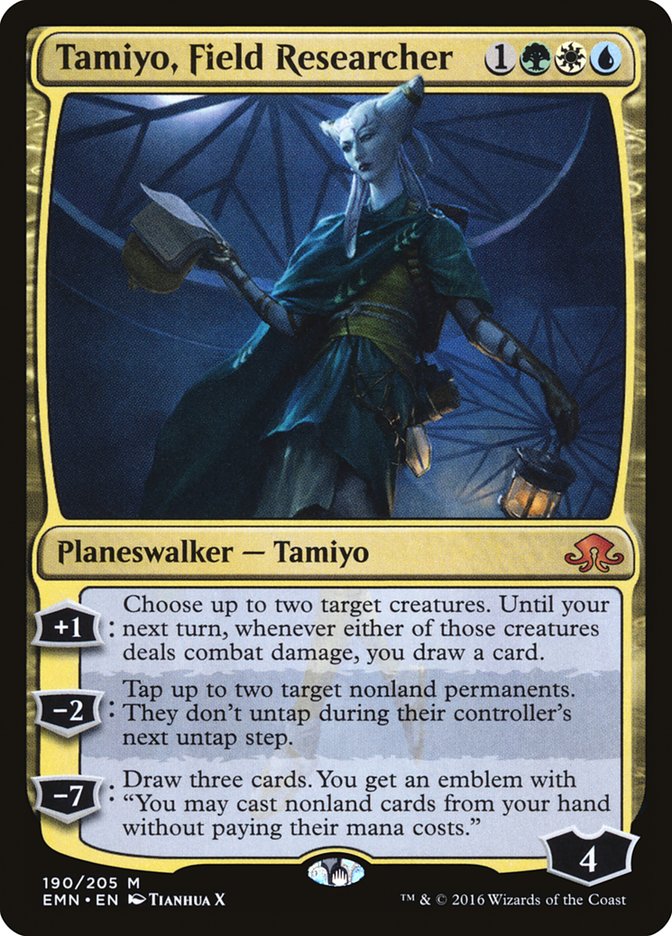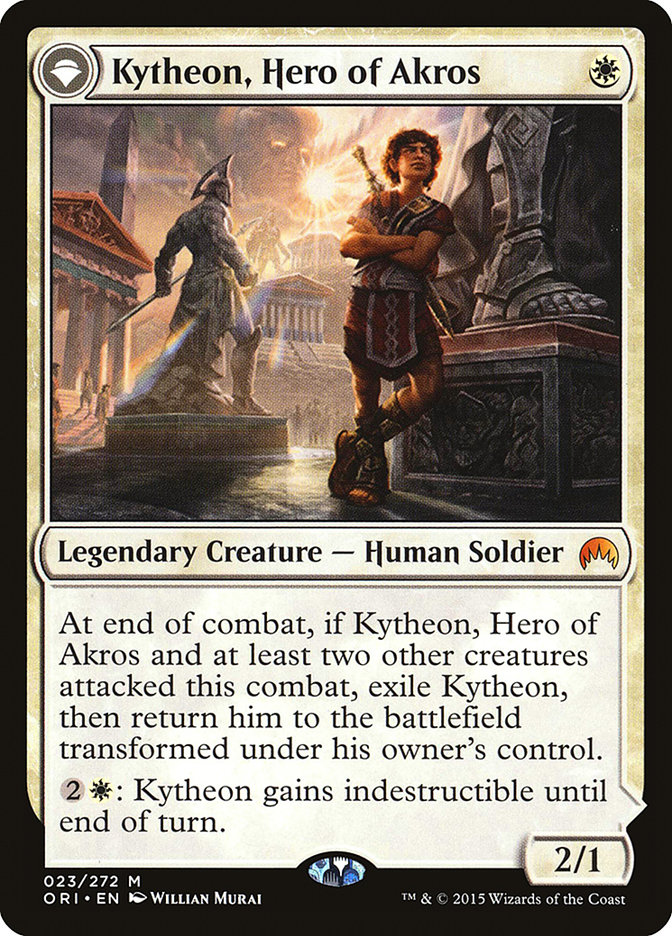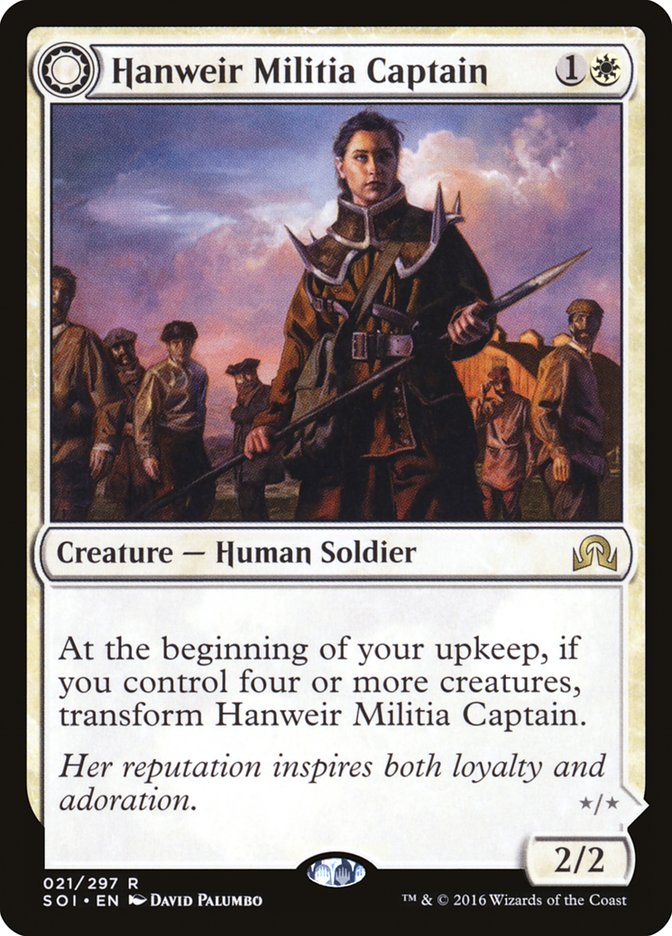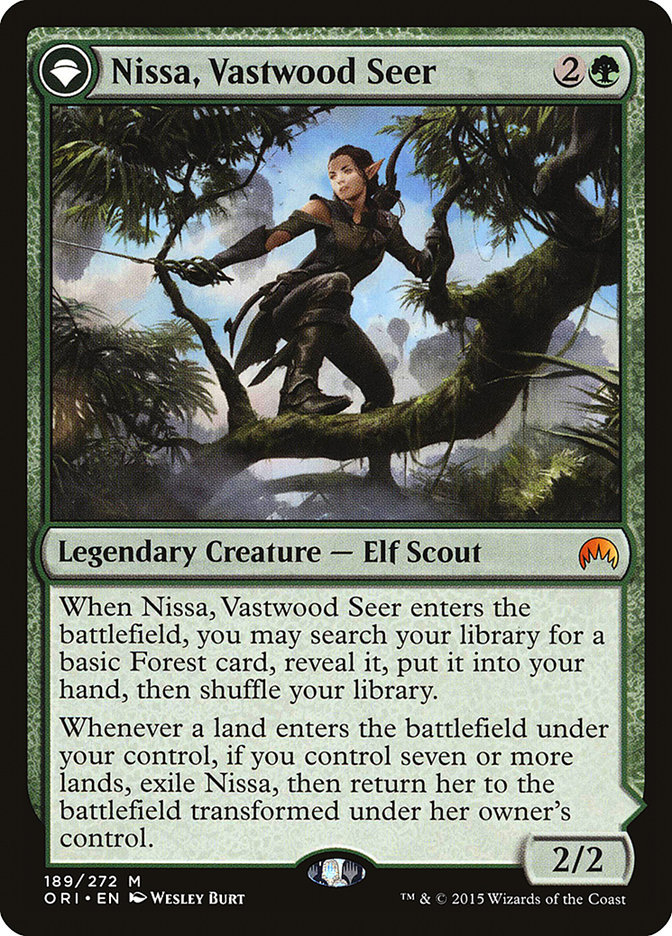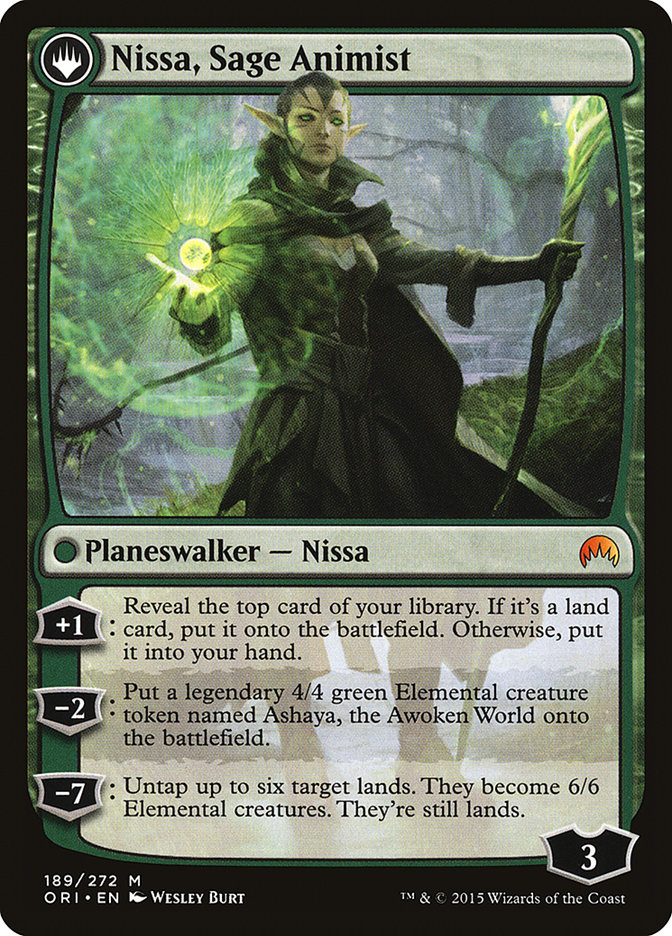Too long; didn’t read: Good cards in; bad cards out. See you next week!
…
In the interest of keeping my column here at Star City Games, it may be best to write an entire article on how to sideboard with Bant Company. For anyone who didn’t get to catch all of the action at #SCGCOL last weekend, it is all summed up in Patrick Chapin’s article on Premium this week. Bant Company was everywhere and I was part of the problem.
Creatures (25)
- 2 Jace, Vryn's Prodigy
- 3 Bounding Krasis
- 4 Reflector Mage
- 4 Sylvan Advocate
- 1 Archangel Avacyn
- 2 Tireless Tracker
- 1 Lambholt Pacifist
- 4 Duskwatch Recruiter
- 4 Spell Queller
Planeswalkers (2)
Lands (26)
Spells (8)

There are a few different variants of Bant Company floating around, and I don’t want to waste too much space talking about card choices in my deck, but sideboarding requires the context of a strategy to be performed correctly and I think it is necessary here.
Going into the weekend, the biggest card to beat seemed to be Spell Queller. For me, that tends to mean I want to be among the best Spell Queller players in the room. This translated to a desire to have the ability to represent Spell Queller as often as possible and cast other spells when the opponent actually played around Spell Queller.
When playing this particular Bant Company list, it often functioned much closer to a Bant Flash shell. Most of the Werewolves in the deck are even better when they are almost assumed to be able to flip by the third or fourth turn every time.
One issue that many people have brought up with three-color decks I the mana. Kyle Boggemes actually had a fantastic piece detailing some of the intricacies behind Duskwatch Recruiter before he made it to the Top 4 of #SCGCOL with the deck. The biggest shift between my deck and Kyle’s is the inclusion of Tamiyo, Field Researcher and playing 61 cards in the deck.
I’m naturally a little biased towards Tamiyo, Field Researcher due to my having the privilege of writing her spoiler article and I was considering playing her whether she was good or not. I originally locked myself in an apartment with Robert Wright and Brent Clift to try to figure out how to combat Spell Queller and all of the various Flash strategies that would be coming to play in Columbus. After several hours and about eight different decklists, it was pretty clear that Tamiyo’s value was primarily in the mirror, with splash applications in other matchups.
After some long Skype calls with some friends from Florida, I arrived at the aforementioned list when they cited how powerful Tamiyo’s -2 ability was against flying creatures.
The Easy Sideboarding
Generally speaking, some matchups tend to be a bit more straightforward when it comes to building a deck that will answer the plan that the opposition is trying to put together.
Humans is a prime example of something that is a bit easier to plan against. Humans being linear (play smaller creatures and attack with them) puts it in a category of decks that is easy to plan for. As a result it becomes relatively intuitive what cards to take out and what cards to put in.
Generally these are the cards to take out against a Tom Ross-styled W/R Humans deck due to the awkward situations they can create in the matchup. When evaluating an opening hand, it is important to note how likely that hand is to be able to beat the opposing deck along the axis that it will fight on.
Most of the cards being cut are not cards that are wanted in an opening hand against a low-to-the-ground aggressive strategy. Spell Quller doesn’t do very much if they’ve already played their spells, Tireless Tracker doesn’t do anything outside of being a vanilla 3/2 before turn 4, and Collected Company isn’t castable before the fourth turn of the game.
From here it is a matter of putting cards in the deck. Generally the best way to beat the creature-based aggressive strategies is to try to create a longer game. This ensures that the average card off the top of Bant Company’s library will outclass the average card off the top of W/R Humans’s library.
All of these cards tend to prolong the game or reduce one’s odds of dying. The Pacifists tend to outsize a good number of the 2/1 creatures that Humans will tend to present. Stasis Snare and Declaration in Stone help answer problem creatures in Kytheon, Hero of Akros and Hanweir Militia Captain. Archangel Avacyn is a little more suspect than the other cards due to her high mana cost, but she gets a pass due to her impact that she can have on the battlefield, doubly so when considering what a game-ending ability Avacyn, the Purifier has against decks revolving around smaller creatures.
Sideboarding becomes a much easier task when considering what the ideal scenario when playing a matchup tends to look like. Against a control deck, it isn’t necessarily as important to have great creatures on defense, so Lambholt Pacifist will likely be moved to the sideboard in favor of a creature that translates well to the late-game, like Nissa, Vastwood Seer. Against a deck that hinges on Eldrazi Displacer, playing removal other than Dromoka’s Command is a good place to be due to the Displacer’s ability to “counter” the “fight” portion on Dromoka’s Command by blinking the Command caster’s creature that is chosen to fight.
The Tough Sideboarding
Not all decks in Magic tend to be as linear as W/R Humans, and as a result not all sideboarding tends to be low-hanging fruit that’s easier to pick up on from the get-go. At the SCG Tour® stop in Columbus this most recent weekend, I played the Bant Company mirror eight (!!) times in fourteen rounds played. What’s the kicker here that matters in the context of this article? I sideboarded differently in every single one of those matches.
When initially approaching the mirror, the first thought was that staying at-parity or better on the battlefield was the most important part of the mirror match. This led to me shaving cards that weren’t particularly good from behind or that required something to “go right” in order to be playable:
Out:
In:
Despite escaping the matchup with the victory, it became abundantly clear that not having an answer to a mid-combat Archangel Avacyn was incredibly problematic. The final game of the first match was nearly decided by my having to make a very strange block to overcompensate for an opponent possibly having Dromoka’s Command. It became painfully obvious that the card was important in the matchup and it shouldn’t be taken out in the future.
The following time that I played the mirror was against Harlan Firer. It can be found on camera here. This matchup in particular taught me a great deal about the match and what is and isn’t important.
In this match I tentatively took out a pair of my Dromoka’s Commands as I didn’t want to overload on them and tried taking out all copies of Bounding Krasis, as well as a copy of Collected Company. I brought in the same cards as before, and as the game played out, I realized a few things:
- Dromoka’s Command should never be below four copies in the matchup. If Eldrazi Displacer doesn’t make its way into the deck, it is far too good at ruining combat math for the opponent, hitting Spell Queller, and answering the opponent’s copies of Dromoka’s Command.
- Jace, Vryn’s Prodigy isn’t quite good enough. In the third game with Harlan I would have been able to mill Harlan’s library via Jace, Telepath Unbound’s ultimate ability, but that was more due to Harlan assessing that it couldn’t be done before turn 5 of extra turns and ignoring Jace as a result. Jace doesn’t do anything in combat as well, and that can be a complete game-changer in a mirror that can be decided in the first five or six turns.
- Archangel Avacyn is likely the most important card in the matchup and it isn’t particularly close.
A very minute strategy that Harlan implemented that I hadn’t considered previously was how drastically Lambholt Pacifist changes the game. It creates a strange subgame in which the Bant Company deck has to play on its own turn in order to keep the Lambholt Pacifist from flipping. This point is exacerbated against the Bant Company decks that tend to rely a non-zero amount of being a flash deck (see: Bounding Krasis). Then, as the game progresses, Butcher of Lambholt tends to scale well from a power/toughness perspective among the other creatures in the deck.
In practice it was common to find myself in game states similar to the third game against Harlan: muddy, complicated, and seemingly never-ending. For untimed rounds it is likely that going bigger is the best solution for the mirror. Becoming a sort of control deck with ways to break battlefield stalls or go so far over the top of the opponent that they cannot compete is a reasonable strategy that is likely the best way to win the mirror…but not for tournament Magic.
Tournament Magic is timed and all three games must be finished within the time limit of a round, generally 50 minutes. This means that each game should last roughly fifteen minutes with five minutes being allotted for shuffling and sideboarding when games aren’t being played. This means that sub-optimal lines of play or strategies have to be implemented at times in order to finish games within a certain time limit.
This theory is often seen being applied in the third game of control mirrors, when there isn’t much time left. People will oftentimes sideboard out cards that prolong the game in order to make room for anything that can be a threat: creatures, planeswalkers, game-ending bombs. This is the best way to make sure that a game doesn’t go to a draw when it otherwise wouldn’t end.
This line of thinking drew me towards trying to take a more aggressive role in the Bant Company mirror, regularly trying to put the opponent on the back foot or staying a turn ahead when racing. By the end of #SCGCOL I was regularly sideboarding as follows.
Out:
In:
Okay, wait.
I imagine there is a significant portion of readers who are pretty close to closing the browser or going to the next article upon seeing Collected Company in the “Out” section. The reason for their exclusion is all in the plan for the mirror match and the pacing of games.
The dramatic shift in the deck between Games 1, 2 and 3 is in the inclusion of Lambholt Pacifist as an aggressive creature. As mentioned previously, Lambholt Pacifist creates a subgame in which it ruins the Collected Company deck’s ability to profitably play a game based on cards with flash. This doesn’t take into account that the front side of Lambholt Pacifist tends to trump a good number of creatures on the battlefield in size before it even transforms. In a world of three-drop 2/3s, a two-mana 3/3 rules the land.
Lambholt Pacifist being a focal point in the deck means that the list has to compensate for the necessity of a four-power creature in the post-sideboard games. Tireless Tracker actually lends itself incredibly well to this theory and the seemingly inevitable war of attrition that the Bant mirror will devolve into. Many games involve casting Tireless Tracker on the third turn, playing a land on the fourth, and immediately cracking the Clue that Tracker spawns in order to have a large enough creature on the battlefield to allow Lambholt Pacifist to attack.
Nissa, Vastwood Seer tends to play a similar role as Tireless Tracker. If left unchecked it will create an insurmountable flow of cards and threats that is nearly unparalleled in this kind of matchup. Generally speaking, it is correct to create Ashaya, the Awoken World as quickly as possible in order to continue to contribute something of worth to the battlefield.
In games where the battlefield is already gummed up past the point of being able to break through, though, building Nissa, Sage Animist to her ultimate is a way to pretty handily lock up victory. Be careful to diversify which lands are targeted. Having an opponent Bend or Break your lands via Declaration in Stone is more than a little embarrassing, I promise.
The reason for cutting Collected Company in post-sideboard games lies in the importance of sculpting a plan in-game. In practice Collected Company is a slightly above-average card a decent amount of the time, great a small percentage of the time, and an absolutely humiliating thing to spend one’s turn on when it whiffs (read: sees no creatures in the top six cards of the caster’s library). Some of the best cards post-sideboard are things that can’t be put onto the battlefield with Collected Company (Archangel Avacyn and Declaration in Stone), and the tension this creates with the power level and consistency of the card generally isn’t worth it.
It is incredibly rare that the Bant Company deck runs out of things to do, and being able to create a gameplan and know what the effects of everything are going to be is crucial when it comes to actually closing a game out. There are naturally the Magical Christmas Land situations in which a Collected Company hits Spell Queller and Reflector Mage in response to the opponent’s most important spell, but it is more likely to hit something that doesn’t quite line up with the exact scenario that is going on. Casting a sorcery-speed Collected Company only to hit Bounding Krasis is embarrassing, hitting Spell Queller on the opponent’s end step is underwhelming, and so on.
Most of the creatures in the Bant Company deck are meant to played within some sort of broad circumstance, and those creatures lose a great deal of value in a mirror match in which the opposing creatures fight on the same axis. Sequencing becomes key and a Spray-and-Pray technique isn’t likely to put one in a winning position.
A single copy of Duskwatch Recruiter is left in the deck due to the power in the first copy that is drawn in the matchup. Duskwatch Recruiter is rarely the most important creature on the battlefield, and as a result, it is rare that players will spend their precious few removal spells on the smaller Werewolf. The pseudo-protection and poor sizing coupled with the diminishing returns that come from drawing multiple copies of Duskwatch Recruiter make Duskwatch Recruiters two through four easy cuts from the deck to make room for cards that will generally be more impactful draw steps.
Going forward, it’s hard to say what I would do with the deck. The popularity of the archetype makes me want to try a version of Bant that leans more towards a dedicated Flash deck in the style of Jeff Hoogland’s U/W Spirits that was featured in a deck tech with Nick Miller.
Creatures (26)
- 2 Jace, Vryn's Prodigy
- 3 Bounding Krasis
- 4 Reflector Mage
- 4 Sylvan Advocate
- 2 Archangel Avacyn
- 2 Tireless Tracker
- 1 Lambholt Pacifist
- 4 Duskwatch Recruiter
- 4 Spell Queller
Planeswalkers (1)
Lands (26)
Spells (7)

Most of the theory here is just pre-sideboarding for the Bant Company mirror in the style of Logan Mize’s Anti-Tokens G/W Tokens deck from #SCGORL earlier this year. When the format becomes so saturated with a particular archetype, the best strategy is to play as closely to that archetype as possible while having a clear plan for the mirror match.
If there’s anything to be certain of going into #SCGBALT this weekend, make sure to be casting Spell Queller, make the opponent unable to profitably quell your spells, or do a little bit of both. Sculpting a gameplan around Wizards of the Coast’s newest format-warping U/W 2/3 is something players will have to do for months to come, so it’s best to start doing it now.


